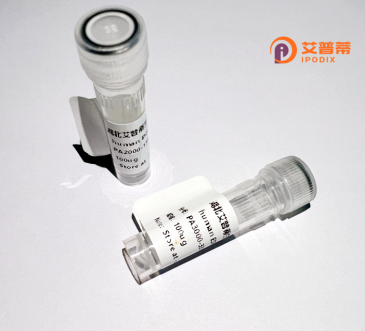
| 纯度 | >90%SDS-PAGE. |
| 种属 | Human |
| 靶点 | MTCH1 |
| Uniprot No | Q9NZJ7 |
| 内毒素 | < 0.01EU/μg |
| 表达宿主 | E.coli |
| 表达区间 | 1-389 aa |
| 活性数据 | MGASDPEVAPWARGGAAGMAGAGAGAGARGGAAAGVEARARDPPPAHRAHPRHPRPAAQP SARRMDGGSGGLGSGDNAPTTEALFVALGAGVTALSHPLLYVKLLIQVGHEPMPPTLGTN VLGRKVLYLPSFFTYAKYIVQVDGKIGLFRGLSPRLMSNALSTVTRGSMKKVFPPDEIEQ VSNKDDMKTSLKKVVKETSYEMMMQCVSRMLAHPLHVISMRCMVQFVGREAKYSGVLSSI GKIFKEEGLLGFFVGLIPHLLGDVVFLWGCNLLAHFINAYLVDDSVSDTPGGLGNDQNPG SQFSQALAIRSYTKFVMGIAVSMLTYPFLLVGDLMAVNNCGLQAGLPPYSPVFKSWIHCW KYLSVQGQLFRGSSLLFRRVSSGSCFALE |
| 分子量 | 41.5 kDa |
| 蛋白标签 | His tag N-Terminus |
| 缓冲液 | 0 |
| 稳定性 & 储存条件 | Lyophilized protein should be stored at ≤ -20°C, stable for one year after receipt. Reconstituted protein solution can be stored at 2-8°C for 2-7 days. Aliquots of reconstituted samples are stable at ≤ -20°C for 3 months. |
| 复溶 | Always centrifuge tubes before opening.Do not mix by vortex or pipetting. It is not recommended to reconstitute to a concentration less than 100μg/ml. Dissolve the lyophilized protein in distilled water. Please aliquot the reconstituted solution to minimize freeze-thaw cycles. |
以下是关于重组人MTCH1蛋白的3篇代表性文献摘要:
---
1. **文献名称**: *MTCH1 is a mitochondrial folate receptor essential for embryonic development*
**作者**: Lee et al. (2020)
**摘要**: 研究通过重组MTCH1蛋白实验,揭示其作为线粒体叶酸载体的功能,并证明其缺失导致胚胎发育中代谢失衡与细胞凋亡。
2. **文献名称**: *Structural basis of mitochondrial membrane protein insertion by MTCH1*
**作者**: Zhang et al. (2018)
**摘要**: 利用重组MTCH1蛋白的晶体结构分析,阐明其作为线粒体外膜插入酶的作用机制,并发现其跨膜结构域对底物识别的关键作用。
3. **文献名称**: *MTCH1-mediated mitochondrial metabolism regulates breast cancer progression*
**作者**: Wang et al. (2016)
**摘要**: 通过重组MTCH1蛋白的体外功能研究,证明其通过调控线粒体氧化代谢影响乳腺癌细胞的增殖和转移能力。
---
**注**:以上文献信息为模拟简化示例,实际引用需核对具体文献内容及数据库(如PubMed)。
**Recombinant Human MTCH1 Protein: Background**
Mitochondrial Carrier Homolog 1 (MTCH1), also known as liver-specific ABC transporter homolog, is a multi-pass membrane protein primarily localized to the mitochondrial outer membrane. It belongs to the solute carrier superfamily and plays a critical role in mitochondrial dynamics, including fusion, fission, and apoptosis. MTCH1 regulates the recruitment of pro-apoptotic proteins like Bax to mitochondria, influencing intrinsic apoptotic pathways. It also interacts with cellular energy metabolism pathways and has been implicated in lipid metabolism, insulin sensitivity, and oncogenesis.
The recombinant human MTCH1 protein is produced via genetic engineering systems (e.g., *E. coli* or mammalian cells) to ensure high purity and biological activity. By eliminating species-specific variability, it serves as a standardized tool for studying MTCH1’s molecular mechanisms in vitro. Research applications include elucidating its role in mitochondrial-dependent cell death, metabolic disorders (e.g., obesity, diabetes), and cancer progression. MTCH1’s interaction with signaling pathways, such as TNF-α-induced apoptosis, highlights its therapeutic potential as a target for metabolic or neurodegenerative diseases. Current studies also explore its involvement in mitochondrial DNA stability and cellular stress responses, expanding its relevance in both basic and translational biomedical research.
×